Are you planning a weekend getaway on your bike or a longer bicycle tour? My comprehensive bicycle touring gear list includes packing solutions, camping gear, clothing, and tools that I have tested over my six years of bike travel.
Damn it, I stay at home and don’t go anywhere, I think every time I start packing for a bike tour. If hell exists, I am convinced that’s what it looks like – packing, decision-making, and trying to stuff everything into the panniers.
The silent voice in my head keeps telling me: You have forgotten about something! I run around looking for things and then face decision paralysis, trying to determine what to leave and pack. Weeping and gnashing of teeth.
Before my first trip, I even burst into tears while sitting among the piles of stuff to pack in the middle of my room. But all in all, it is just about finding a system. The first time is the worst: you cannot imagine what awaits you on your trip.
Below, you can find my list of things I pack for bike tours, along with some recommendations for the gear I use and am happy with. There is no one-size-fits-all – this list can only serve as inspiration for finding what works best for you.
This post may contain affiliate links and I may earn a small commission when you purchase products by clicking on the links (at no additional cost to you). It will help me keep working on this blog. Thank you for your support!
Bike and cycling gear
Bicycle
Is the bike in your basement good enough for a tough bike tour? I know people travelling the world on folding or supermarket bikes. I have one motto: it is always better to go than not to go, even if you only have a crappy bike at your disposal.
Sure, conquering the alpine passes on a Dutch omafiets with three gears is a debatable pleasure, but it is also a good challenge. The main point is to have a working bicycle, although, of course, it is more pleasurable to ride a decent bike.
I am currently touring on a Giant Talon 29 1 mountain bike. It allows me to leave the paved roads and comfortably cycle on bumpy or sandy trails. It has never let me down, and I am happy with it. However, I wouldn’t recommend it if you travel mainly on asphalt roads or want something very comfortable; this sporty MTB position isn’t for everyone.
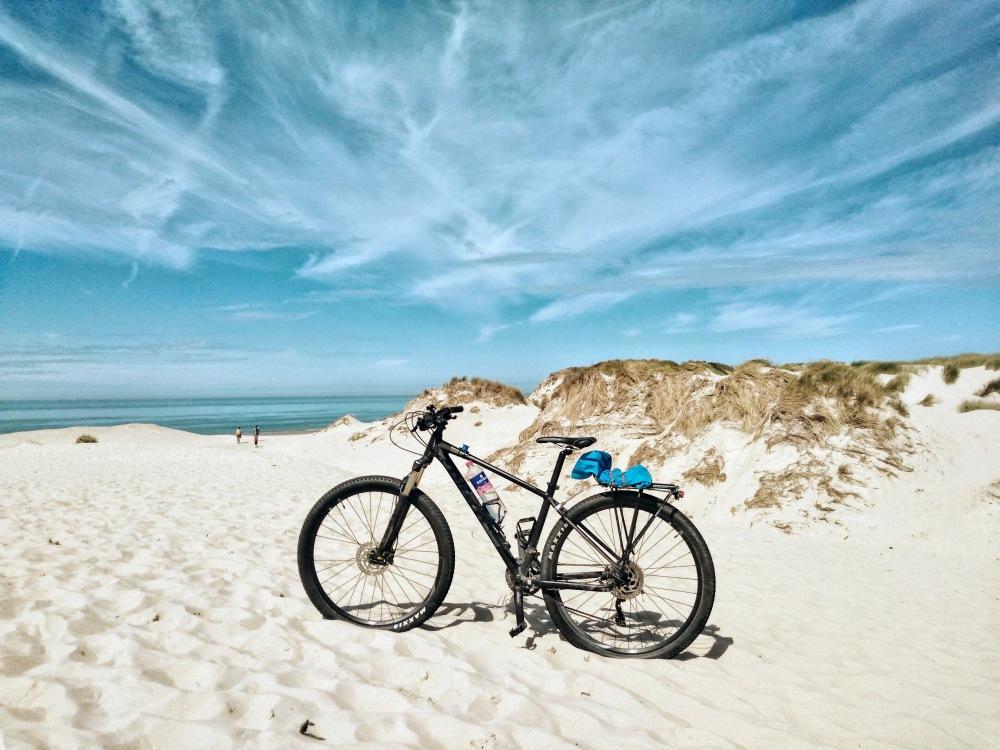
Other popular bikes for bicycle touring are:


Lights
I rarely cycle in the dark, but my bike has a front and rear light. I use a basic Lidl set I bought in Belgium for €12. It is charged with a USB-C cable, which is very convenient and strong enough to make me visible after dusk. If you plan to bike in the forest or on poorly lit roads at night, get something with more lumens (at least 150 lumens).
Here are some bike light sets I recommend:

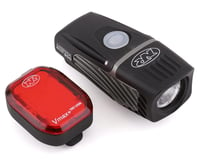
Reflective vest
A basic reflective vest from a hardware store, for a few euros, can save your life in fog or inside tunnels.
Water bottle
I usually carry two bottles on my bike, along with some extra water in a plastic bottle in my bags. There’s nothing more disgusting than warm water from a plastic bottle on a hot day, so I recently decided to spend a few extra bucks on insulated water bottles. I especially like this one from Camelback – it has a mud cap and a lock mechanism that prevents spilling.
Lock
To keep my bike safe, I use a chain lock. It is pretty heavy (more than 1 kg) but that’s the price I am willing to pay for having something a thief cannot cut in five minutes. A good U-lock will also protect your bike well. No lock will keep your bicycle 100 % safe from theft, but if you want to make the job harder for potential thieves, aim for a lock with a security rating of 8 or higher.
Chain lubricant, a cloth and an old toothbrush
Keep the chain clean and apply chain wax regularly to prevent your bike from making weird noises and causing trouble. I use an old toothbrush and a wet cotton cloth to remove the dust and dirt from my chain on the way.
Pump
I am happy with my Giant Control Mini Combo Enduro. It is attached to the frame, weighs nearly nothing, and pumps almost as good as a garage pump.
Update: I am no longer happy with my Giant Pump, which broke down after about two years. I had been using a small pump bought at Lidl for the last two years, but it was unreliable too.
I am currently using a small pump from Decathlon, and it works surprisingly well for its price of 17 euros.
A spare inner tube and patches
I usually carry one spare inner tube and a set of self-adhesive patches to fix the small punctures.
Tyre levers
Essential to change the inner tube.
 Park Tool Tire Lever Set
Park Tool Tire Lever Set
Multitool
I’ve been using the cheapest multitool from Decathlon for a couple of years. Although it is not at the top of ergonomics and versatility, it has all the essential Allen keys to assemble my bike at the airport and fix the basic faults. I can also definitely recommend this small multitool from Park Tool.
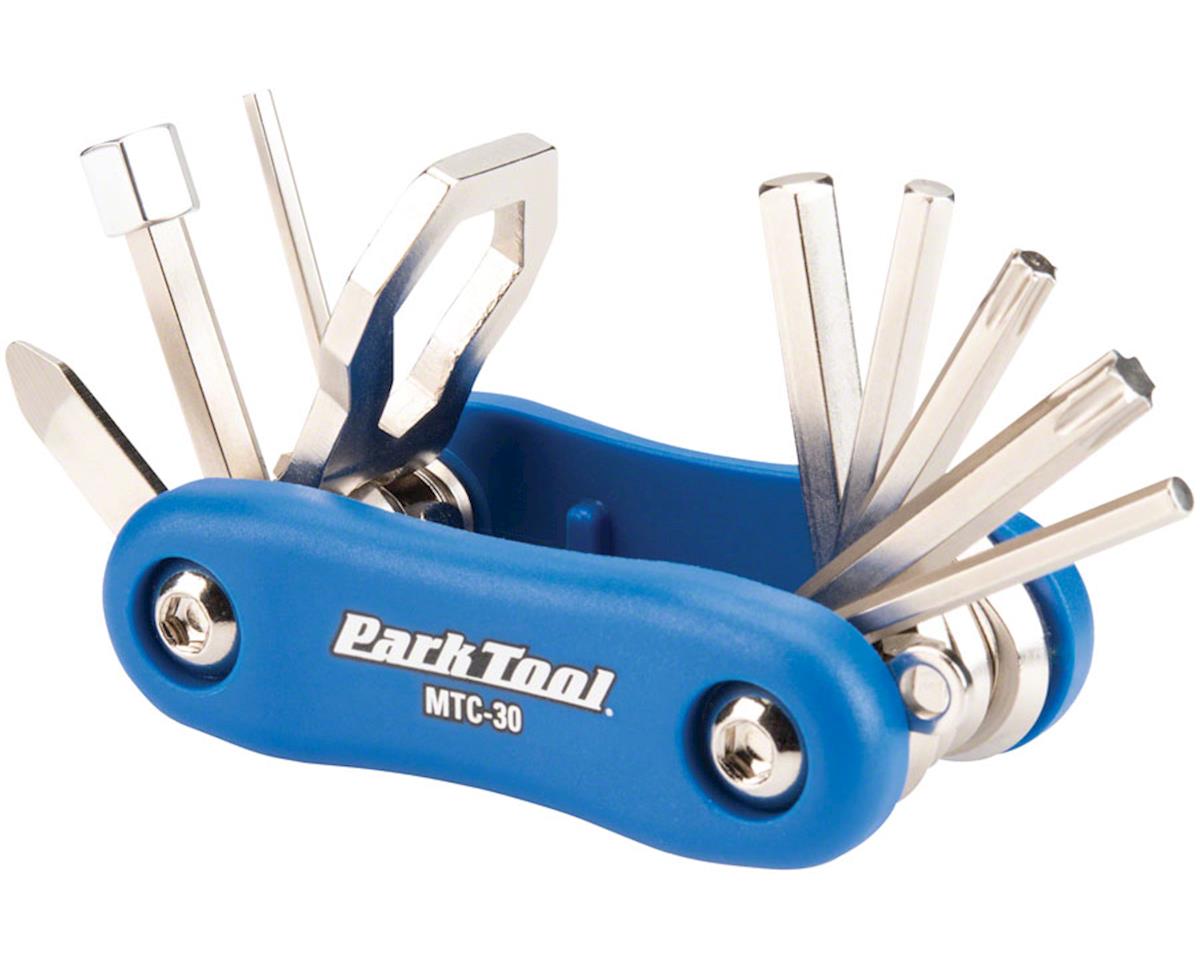
Zip ties and duct tape
Zip ties and duct tape are universal means of fixing everything, at least temporarily.
Bungee cords
To fix everything on the luggage rack. I also use the bungee cords to hang my laundry.
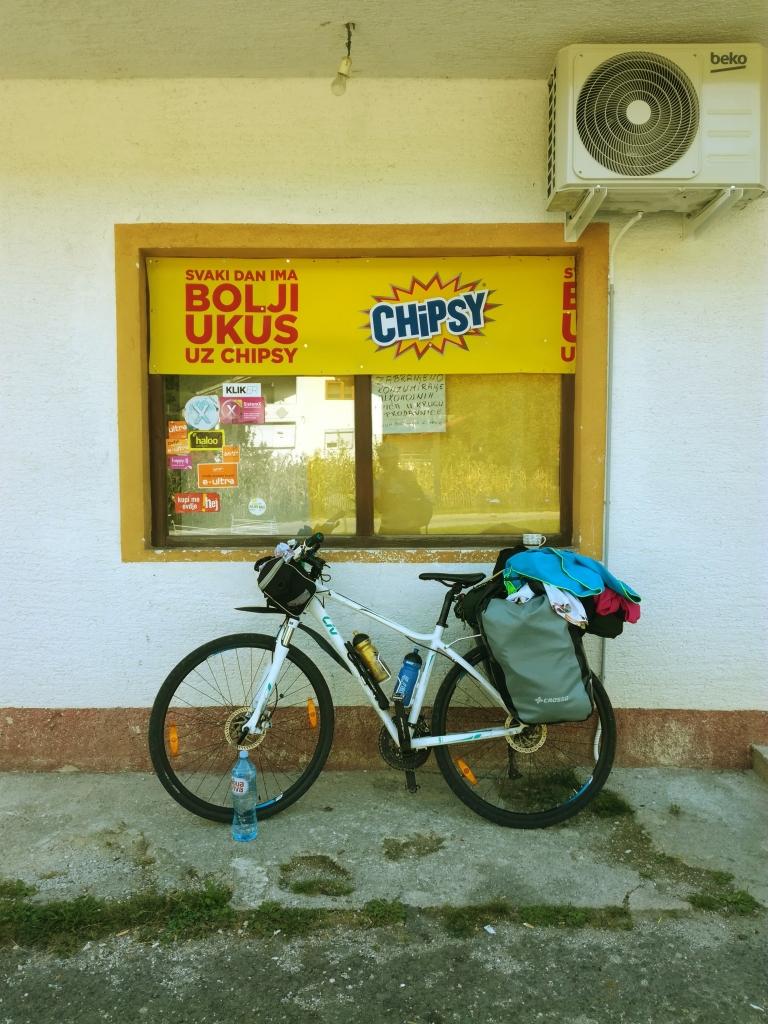
Helmet
A helmet can protect you from serious head injuries. Make sure your helmet fits properly. It doesn’t necessarily have to be expensive, but be aware of counterfeits sold on Amazon by shady companies—they often don’t offer any protection at all (this video about how bike helmets are tested is super informative).
Smartphone holder
I use my phone for navigation, and thanks to the Quad-Lock phone holder, I can mount it securely on the stem or handlebar, giving me easy access at all times.
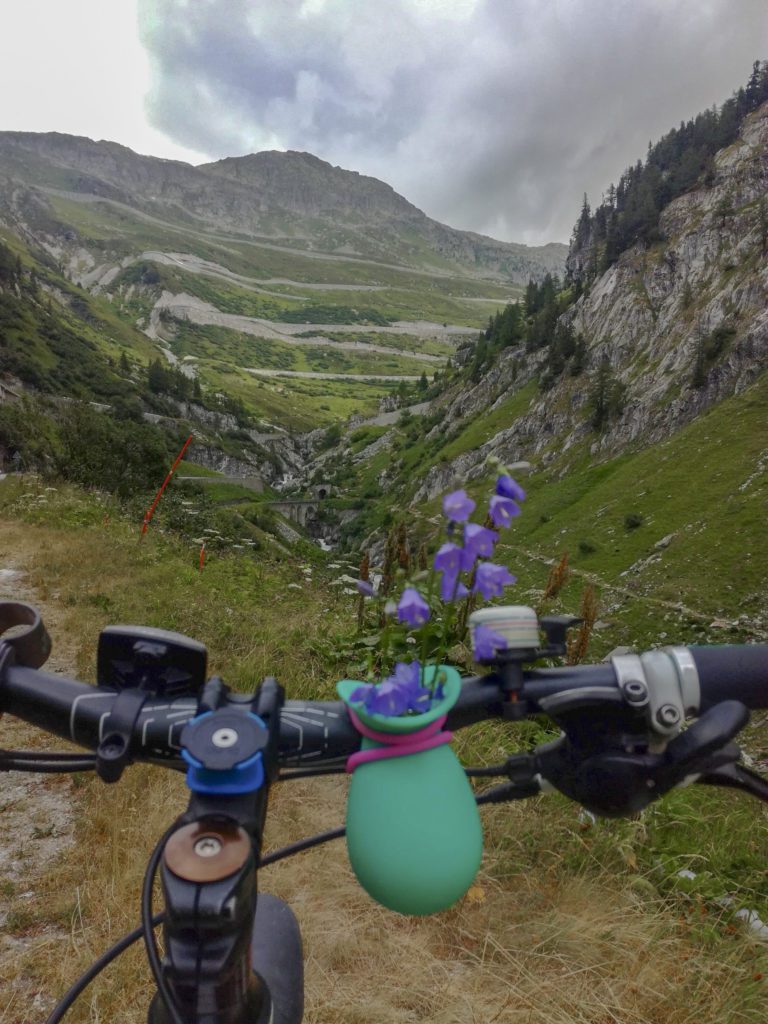
Bags
Panniers
For me, a pair for the rear rack is enough, although many people claim it’s better to distribute the weight evenly on the front and back. My rationale is that if I take more bags, I’ll also take more stuff and will have to carry too much.
I am using the Crosso Dry 60 with the click system (read my review of Crosso Dry 60 panniers here). They are sturdy, waterproof, and light. They are produced in Poland and are way cheaper than the world’s market leader, Ortlieb. The click system is a bit expensive and less durable, but it makes taking the bags off and putting them back on easy and fast. It is also compatible with any baggage rack.
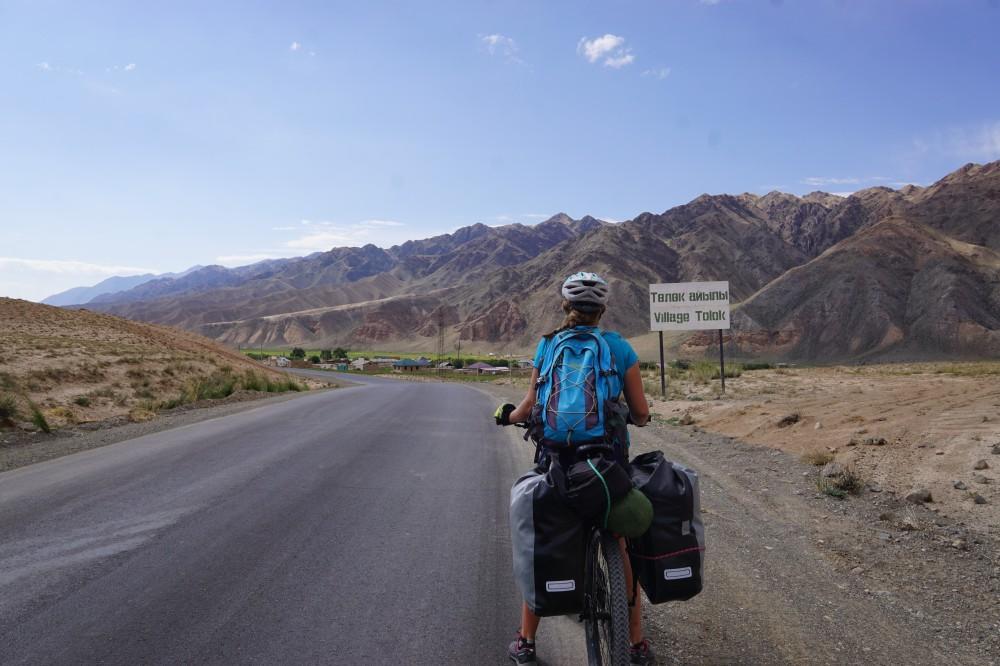
Handlebar bag
I am using the Agu Venture handlebar bag. It is more spacious than most handlebar bags (17 litres). It’s a bit pricey but easy to attach, lightweight, waterproof, and made from eco-friendly and recycled materials.
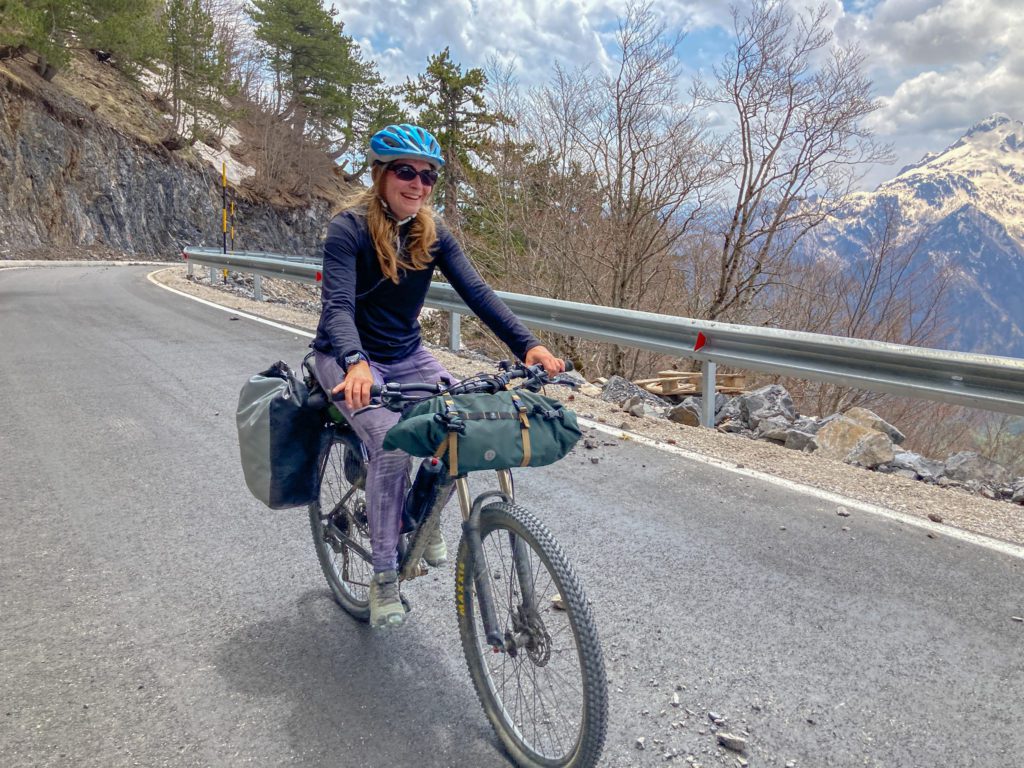
Snack bag
For many years of bicycle touring, I struggled with eating regularly. I forgot, and I was too lazy to take something out of my panniers. That’s why I bought a snack bag—a small bag that you can place on your handlebars to keep the snacks handy while riding.
I’m using a handcrafted bag from Baby Legs Bags.
Backpack
I bring a small backpack for when I go hiking or walking around cities.
For cycling, I attach the backpack to the top of my luggage rack with bungee cords.
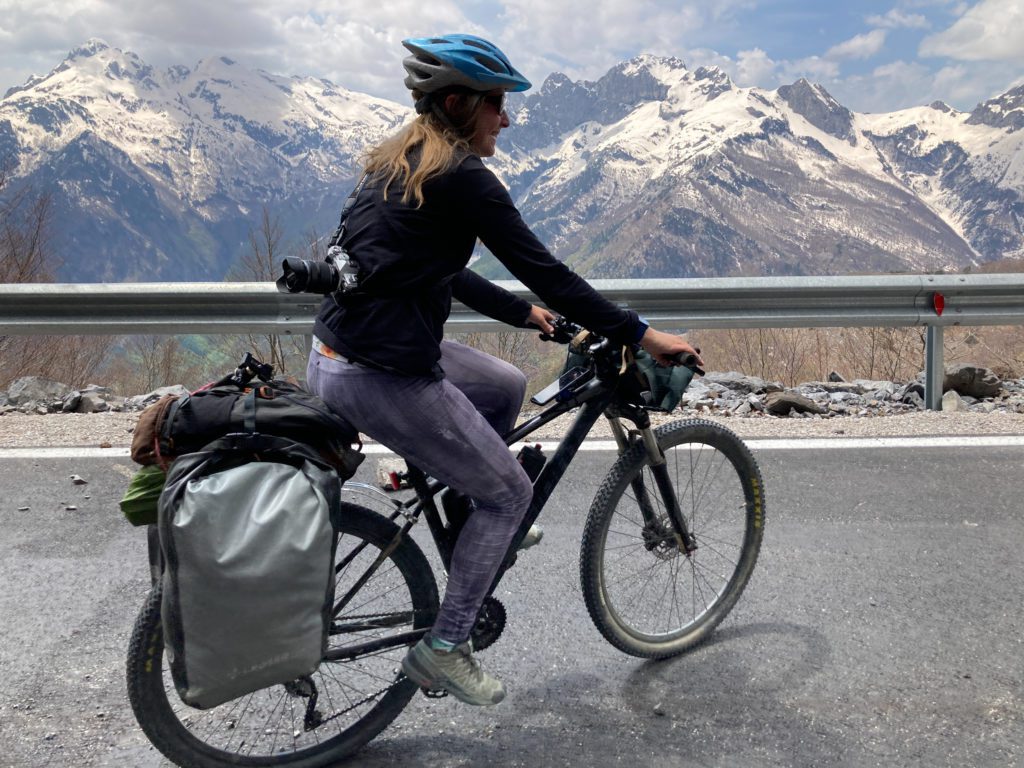
Clothes
Depending on your destination and the time of year, you’ll need to adjust the clothes you pack for a bicycle tour. My list is prepared for summer or early autumn trips, taking into account unpredictable mountain weather.
T-shirt
I bring two T-shirts made of breathable fabric. I’m a big fan of this super-cheap T-shirt from Decathlon (Quechua MH100). I’ve had it for a few years already, wearing it constantly – not only while travelling but also for a workout at home – and it still looks new.
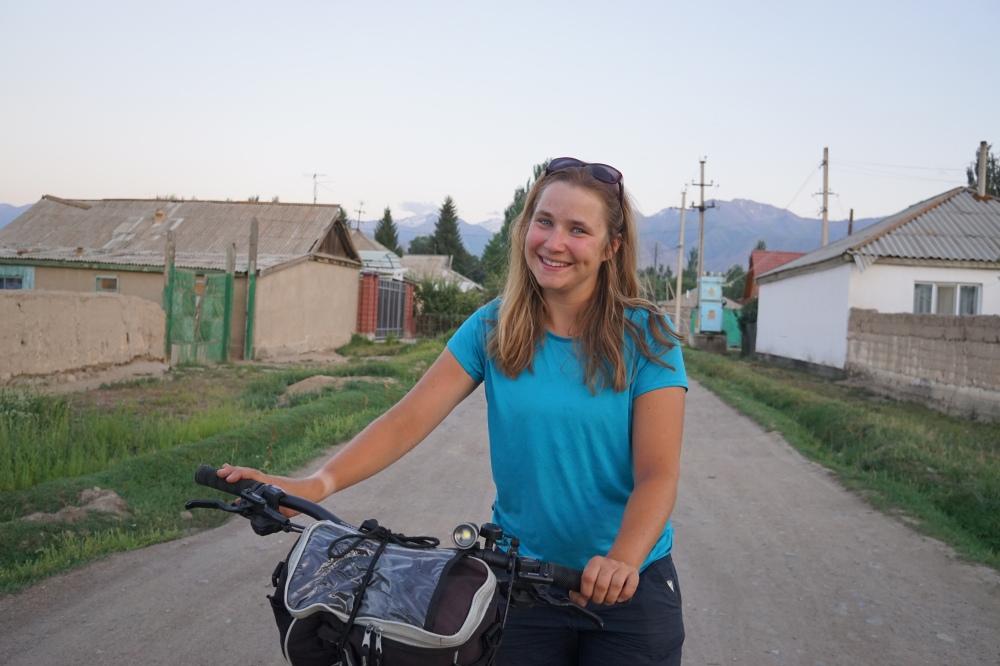
The best choice for long tours is Merino wool T-shirts. They are light, dry quickly, and don’t smell, even if you wear them for longer than one day.
I have a rotation system: one t-shirt on me, and another (washed after being worn the day before) is drying on the luggage rack.
Cycling shorts
I carry two padded cycling shorts. Is it a must-have? Not really. If you have a perfectly comfortable, soft saddle, you’ll survive. But for me, good padded shorts save my ass. Literally.
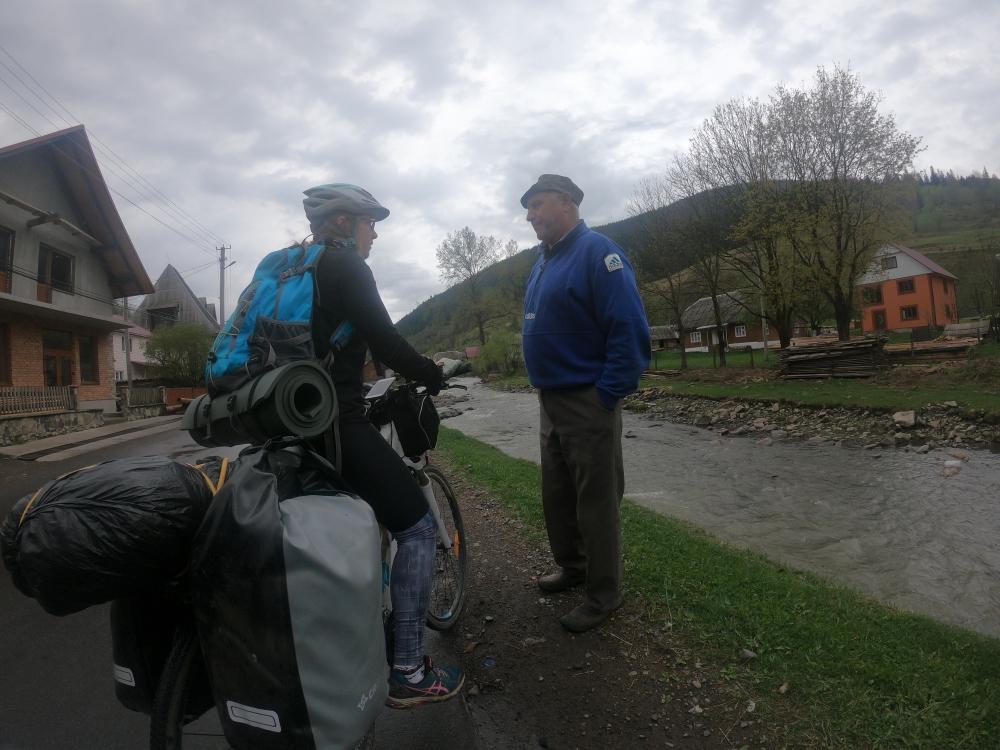
Windbreaker
A windbreaker or something to wear on your back when it’s chilly. Very useful on long downhill rides in the mountains.
Hoodie/sweater
Something properly warm to wear in the evening and to sleep in when you’re camping and the nights are cold. I love my Patagonia hoodie – it’s very comfy and keeps me warm even when it’s freezing.
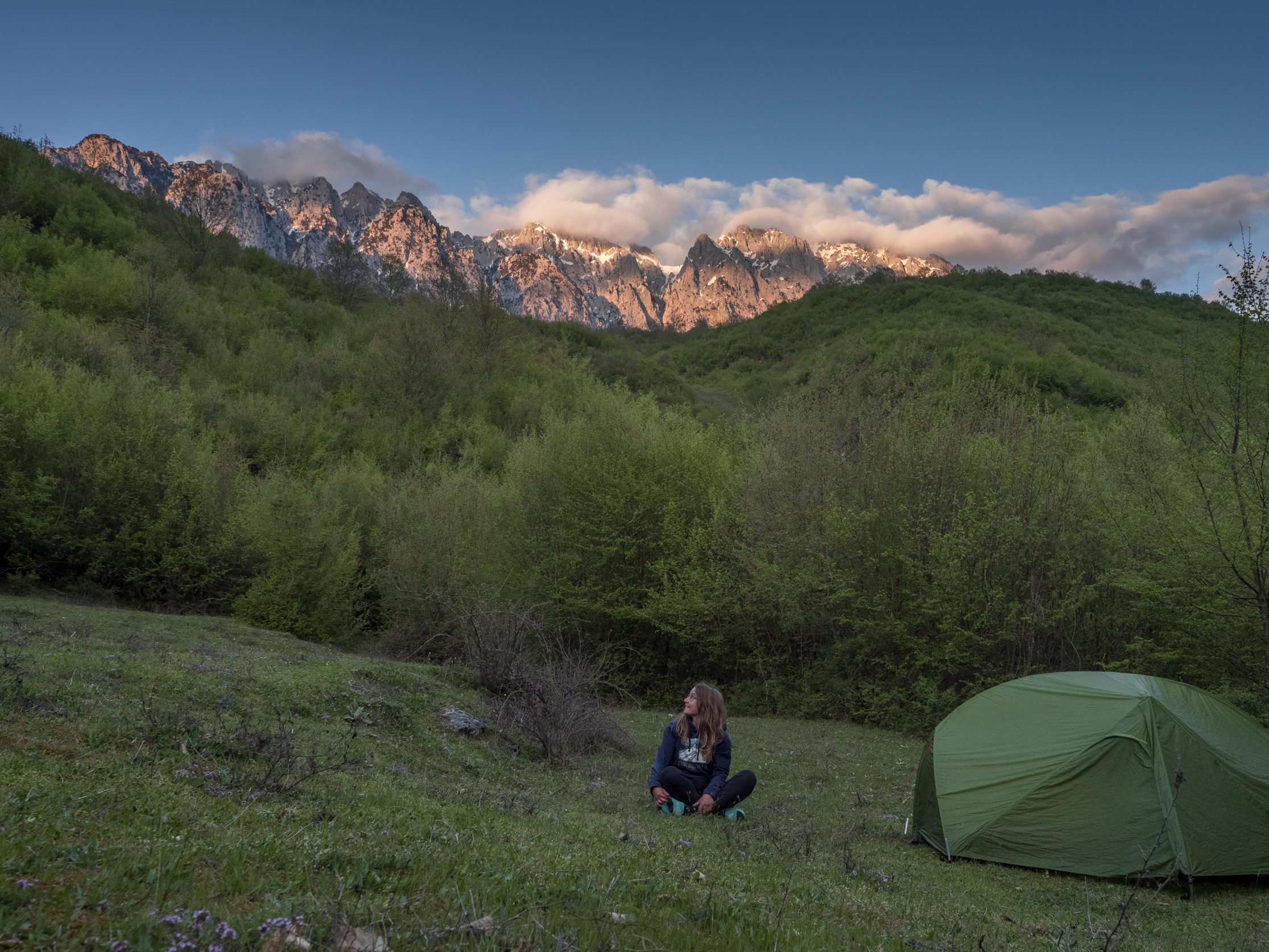
Waterproof pants
A pair of good, waterproof trousers has made my life so much better on many rainy and cold days. They usually also have good wind-stopping properties to keep you warm. Choose something made of breathable materials; otherwise, you will be protected from external humidity but may still sweat too much.
Rain jacket
Most people hate cycling in the rain, but having a good rain jacket can make it at least bearable. You should look for something with a waterproof rating of 20k. I used a Patagonia Torrentshell jacket for almost seven years, and it kept me dry even in heavy rain.
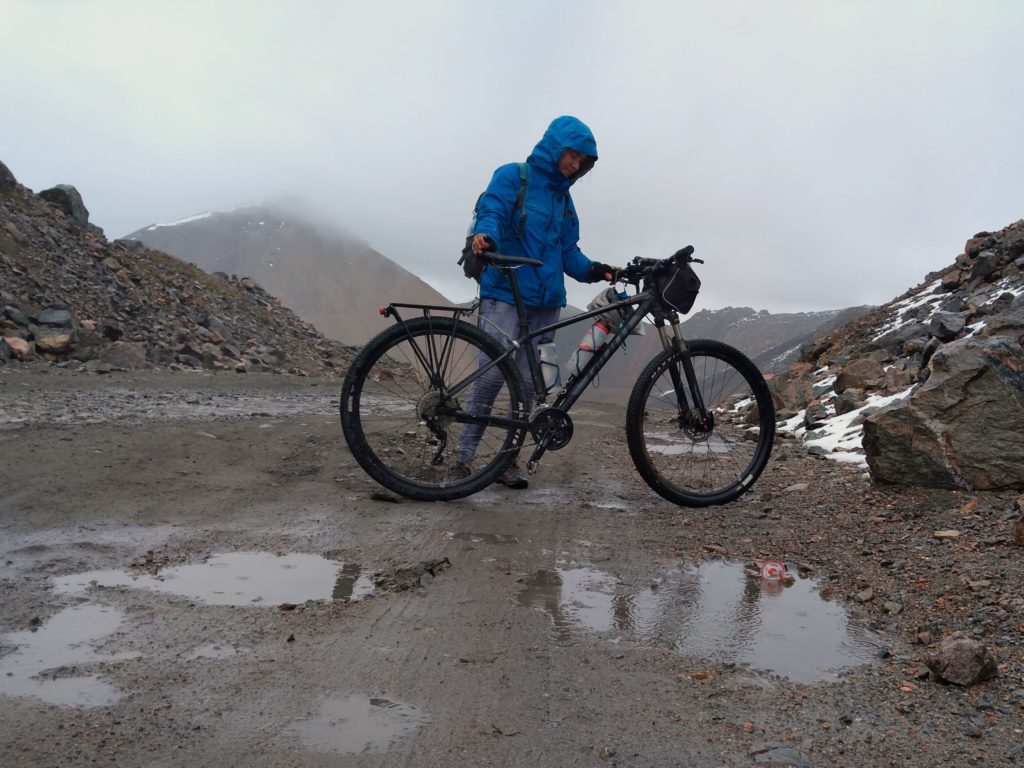
Plastic raincoat
It weighs nothing, takes up no space, and can save you in the pouring rain when every jacket would already be soaked. It’s not to be used for a long time because you sweat in it like a pig, but it’s perfect for short, intense rain.
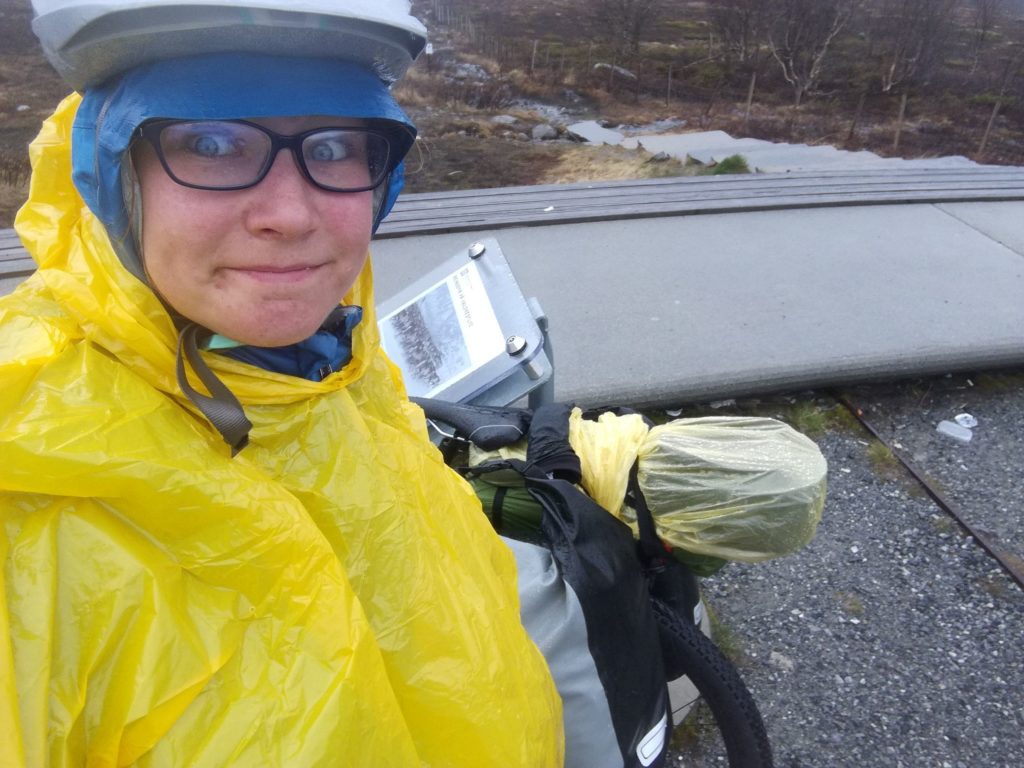
Rubber gloves
They keep your normal gloves dry when it’s cold and rainy, preventing your hands from freezing.
Gloves
I usually wear cycling gloves without fingers and a pair of skiing gloves if I plan to cycle high in the mountains. These gloves made my life much more comfortable when I was camping in the Tien-Shan mountains in Kyrgyzstan at -3 Celsius.
Buff
You can use it as a headband, scarf, or hat.
Shoes
When I started bicycle touring, I used SPD cycling shoes and pedals. I decided to replace them with platform pedals, and now I only carry one pair of shoes for cycling and walking. Usually, I opt for a pair of trail running shoes, which are lighter than hiking shoes but have a good grip in case I want to hike in the mountains.
Civilian clothes
Two or three T-shirts, long pants (better thin and not as heavy as jeans), and shorts.
Something to sleep in
Usually, a T-shirt and shorts.
Toiletries
I have written a separate article about my bicycle touring toiletry bag. You can read it here.
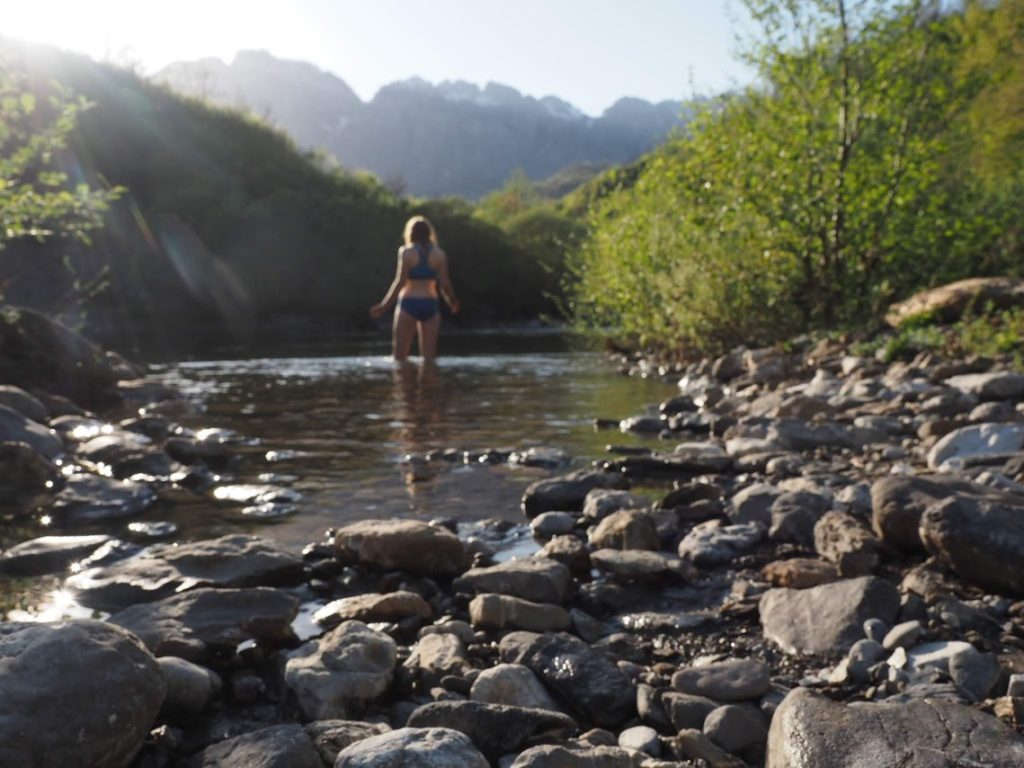
First aid kit
The essentials:
- Gauze swaps
- Adhesive bandage
- Band-aids
- Emergency blanket
- Disinfectant spray
- Ibuprofen
- Diarrhoea pills
- Effervescent electrolytes tabs
Camping gear
Tent
I use Fjord Nansen Tromvik II. It is a light (less than 2 kg) two-person tent that can survive even under challenging conditions.
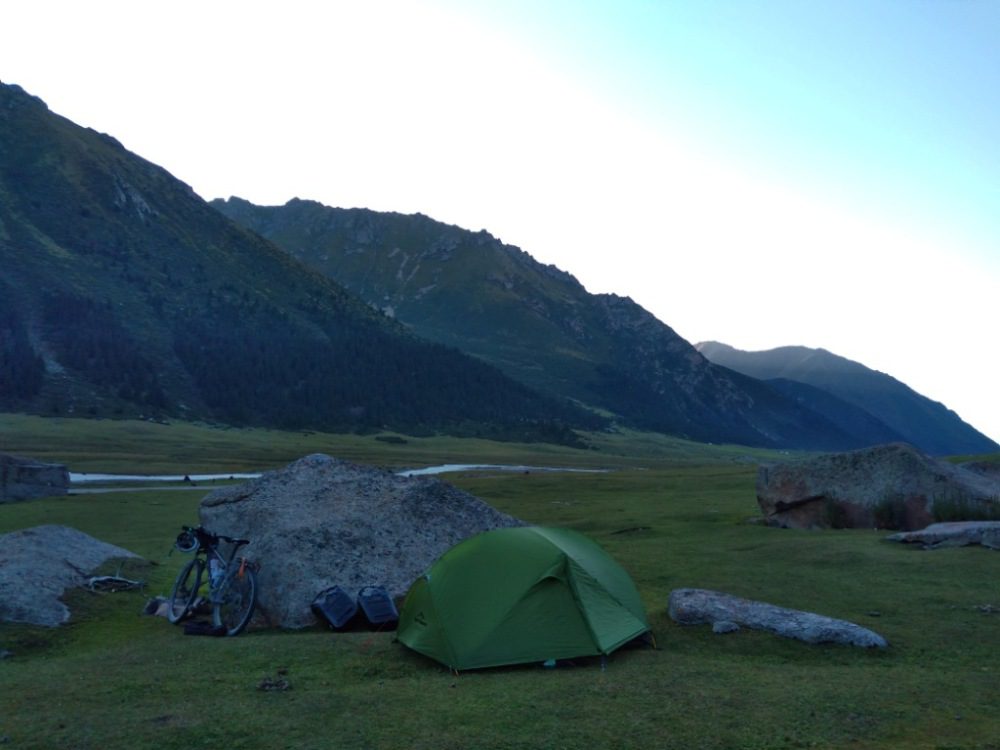
Sleeping Mat
I recently replaced my old and broken self-inflating Fjord Nansen Map with a lightweight Klymit Insulated Static V sleeping pad. So far, I love how comfortable it is, especially considering its low weight (569 g) and how compact it packs. I haven’t had a chance yet to test it in cold weather, so I’m still unsure if the insulation (R-value = 4.4) is as good as the producer promises.

Sleeping bag
I am using The North Face Kazoo down sleeping bag. It weighs less than 900g and is warm enough to get a good night’s sleep in sub-zero temperatures.
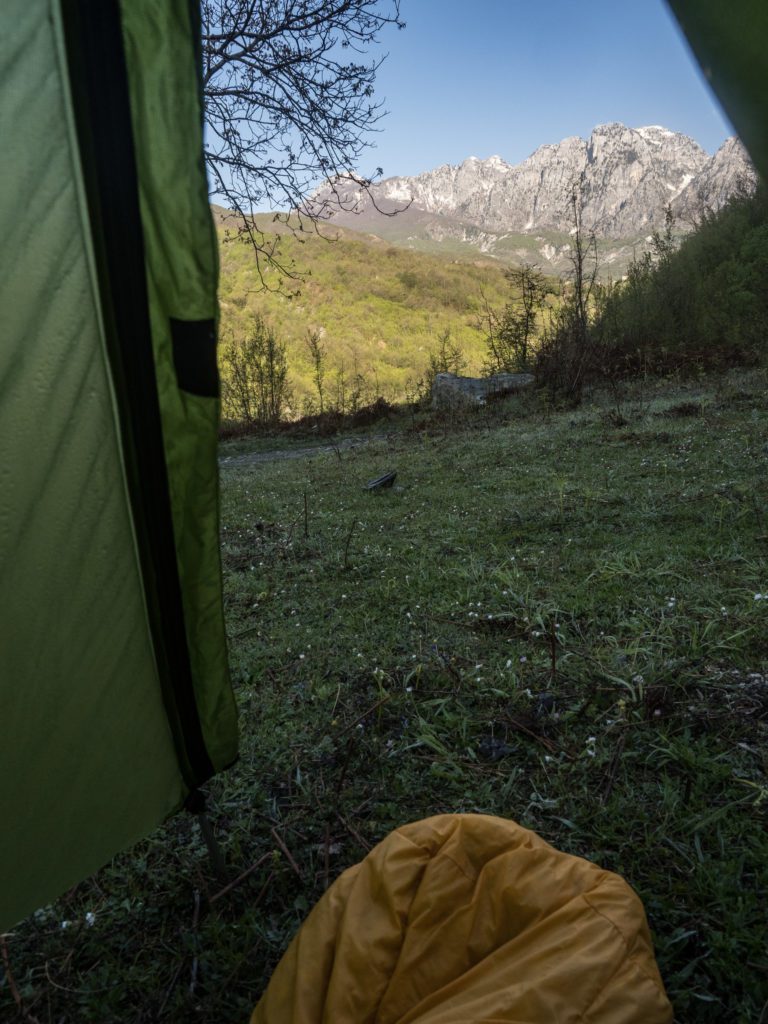
Cooking gear
Stove
I mostly use a multi-fuel MSR WhisperLite International V2 Combo that runs on petrol, kerosene, and white gas. It’s better than a gas stove in places where cartridges are hard to find.
When travelling in Europe without having to fly to the start of my route, I borrow a smaller and more compact gas stove from my dad. It’s easier to use and less messy.
Pot
I cook in this Decathlon pot, which comes in a set with two bowls and foldable spoons.
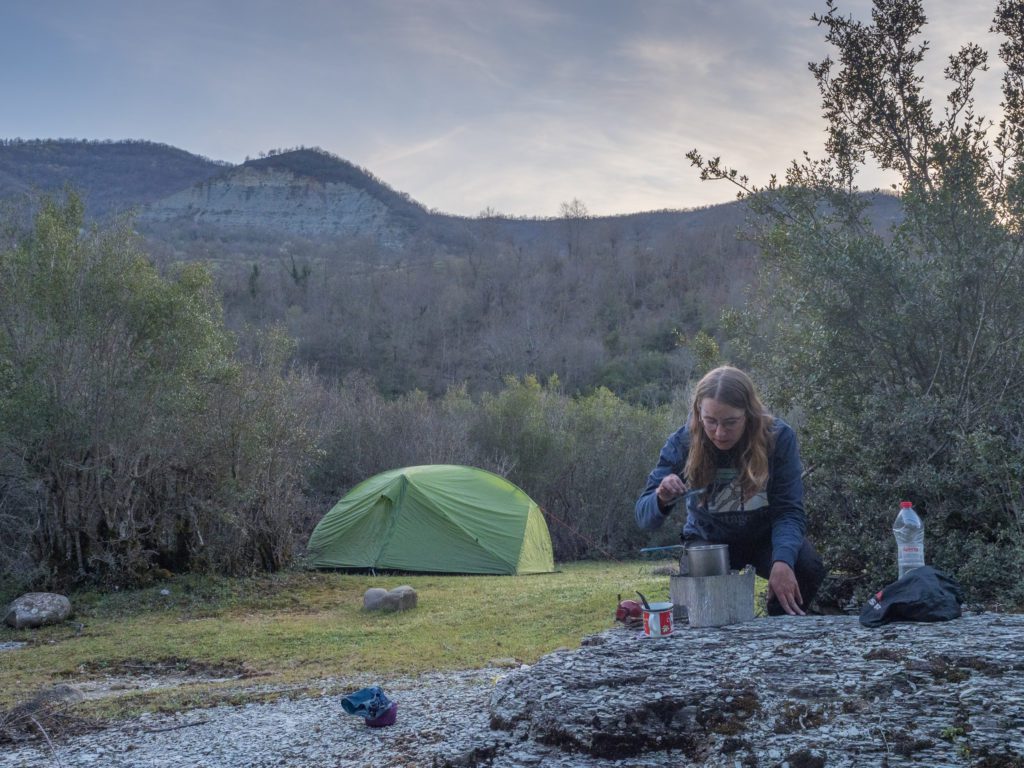
Mug
I carry a lightweight aluminium mug that can also be used directly on the fire.
Swiss army knife
Since 2015, I’ve been using a Victorinox Handyman, which is still super sharp and features a knife, can opener, wine opener, mini saw, and a couple of other functions.
Headlamp
A headlamp is necessary if you’re planning to camp. I also used it when my bike’s front light broke. I have a Petzl Tikka headlamp and have been using it for 8 years.
Water filter
A good water filter removes bacteria, parasites and microplastics. I always use my LifeStraw filter if I’m not 100% sure that the water source at my camp is clean. A good alternative to a water filter is water purifying tablets.
Electronics
Phone
We all know we wouldn’t survive without a phone these days…
Camera
For many years, I carried a Canon DSLR 550d with an 18-55mm kit lens. In 2021, I switched to an Olympus OM-D E-M5 Mark III with a 12-40 mm pro lens.
It is not only more compact and lighter but also water-sealed. I also appreciate that it can be charged with a USB-C cable, so I can use my power bank for charging when I am wild camping and don’t need to bring spare batteries.
Travel tripod
When you travel solo and want to have pictures of yourself, or if you want to take nice night shots, a tripod is a must! I used to carry a mini tripod with flexible legs that you can attach to trees, poles and other things, but it recently broke. I decided to replace it with a light and cheap regular-size tripod. I chose Camprock CP-530 because of its compact size and additional converter for use with a smartphone.
Powerbank
I use the Reinston 20,000 mAh power bank, and so far, it’s been working quite well, allowing me to survive for about four days without access to electricity.
Solar panel
For five years of my cycle tours, I relied only on a power bank. I had to stay in a hostel or a B&B once every few nights to recharge my electronics. Since I bought a solar panel, I am more independent.
Other
Sports watch with GPS
When I’m not cycle touring, I love to run, and a sports watch with GPS makes training and tracking my route easier and more fun. I recently replaced my old Garmin Forerunner 630 watch because its battery capacity had dropped drastically after over 8 years. Now, I use a Garmin Fenix 7 which can survive a few days on a bike without charging.
Revolut card
The Revolut bank card has saved me a lot of hassle (and money) while travelling abroad. You can exchange currencies in the mobile app with a very favourable exchange rate (just don’t do it on weekends, when there is an extra fee) and withdraw money from many ATMs abroad without any additional costs. Since I’ve got Revolut, I rarely go to exchange offices.
If you want to try Revolut out, you can use my referral link. If you do, I will receive a small commission, which will help me work on this blog. Thank you!
Sunglasses
I have sunglasses adjusted to my sight defect, so I don’t have to wear contact lenses while wearing sunglasses.
Insurance card
I never travel without insurance. Shit happens, very rarely, but it happens and I don’t want to be in a situation where I have to pay a gigantic bill for a hospital stay. Currently, I am insured with SafetyWing. My trips are often with an open end and I don’t always know for how long I will be needing insurance. SafetyWing automatically renews every four weeks and I can cancel it whenever I want if I am coming home. Edit, 06.02.2023: I realised I did an oopsie with buying SafetyWing insurance, as it doesn’t cover bicycle touring. I am switching my insurance now to a Polish provider PZU. Lesson learned: always read the insurance policy carefully and by every doubt get in touch with the provider to clarify whether or not your insurance covers bicycle touring.
Edit, 23.01.2024: SafetyWing recently changed their policy and now bicycle touring is covered! If you’re looking for good insurance for long-term bicycle touring, I definitely recommend them.
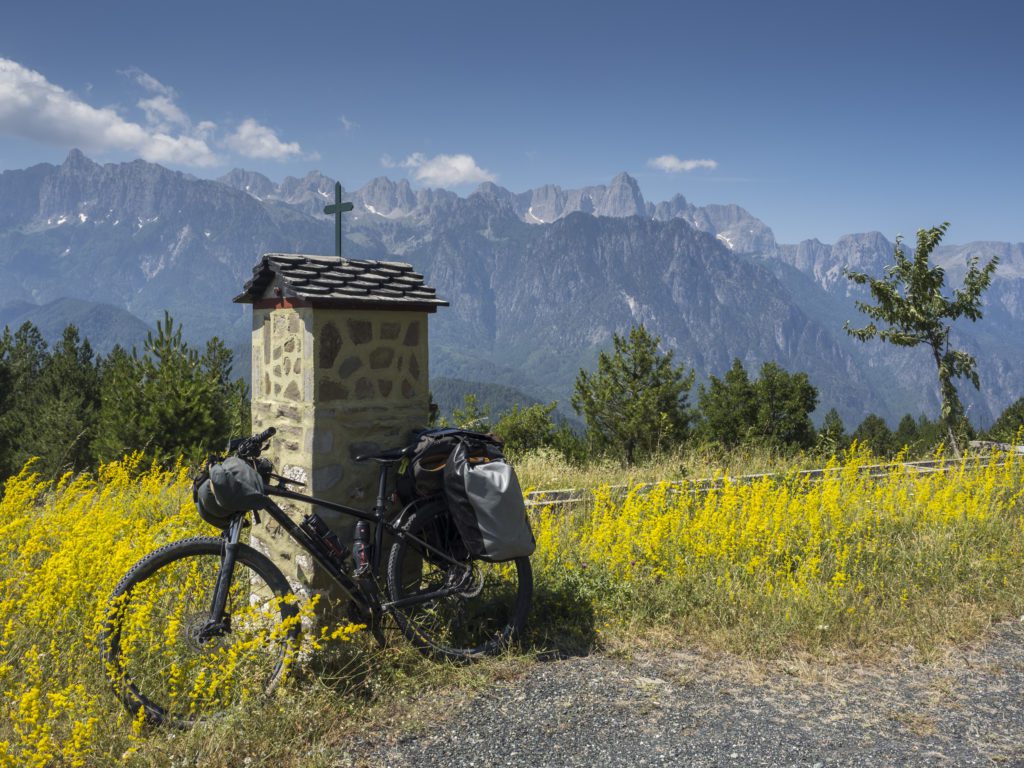
Pingback: Bicycle touring first-aid kit - Wobbly Ride
Pingback: Best navigation apps for bicycle touring - Wobbly Ride
Pingback: How to choose a sleeping bag for bicycle touring? - Wobbly Ride
Pingback: Best panniers for cycle touring - is Crosso Dry the best low-budget alternative for Ortlieb? - Wobbly Ride
Pingback: Hygiene on a bicycle tour - what I carry in my toiletry bag - Wobbly Ride
Pingback: 10 things you need to know before your first bicycle tour
Pingback: How to fix a broken tent? - Wobbly Ride
I’ve just cycled from Dieppe to Paris and back along the L’Avenue Verte. We stayed in Versaille for 2 nights………less expensive than Paris.
I discovered the Cyclers app. It’s free and superb to use………….I got over 4 hours battery usage on my ‘phone and was able to recharge the battery when I stopped for coffee / lunch.
Cyclers a great discovery.
Hi Duncan, that sounds like a great trip and Versaille is so lovely! Thanks for recommending Cyclers, I’ve never heard of it but I googled it now and it looks promising, I’ll need to give it a try!
Cyclers is easy to set up but you need to spend a couple of minutes initially to get to grips with the setting up the route selection. I am not very technical but managed the app successfully. I have not upgraded to the subscription version of the app and feel that I don’t need to. Cyclers is great for leisure cycling and for not getting lost! I don’t feel any requirement to buy a Garmin type device.
Pingback: 17 Christmas Gift Ideas for Outdoorsy People - Wobbly Ride
Pingback: Everything you need to know about travelling by bicycle
Instead of using/ buying a snackbag, the effect would be the same if you cut a 1.5 ltr plastic bottle and use the bottom part. Just make 2 holes on top and 2 at the bottom so that you pass a string/ lanyard or whatever you have handy and tie it to the frame or the handlebar. Do not forget also to hole the bottom so that when it rains, the water leaks down
Although not fancy at all, the ‘snackbag’ serves the purpose.
That’s a good life-hack, thanks for sharing!
If you’re still searching for waterproof pants, I can recommend Montane Atomic Pant. I’ve used them for several bike tours as well as everyday commuting in rainy Denmark. They’re lightweight and compact. A nice feature is that the lower leg can be adjusted so you avoid flappy trousers hitting the bike chain.
Thanks for the recommendation, Christian! I’ve just checked them out and I love the fit.